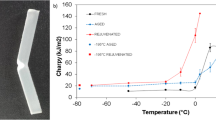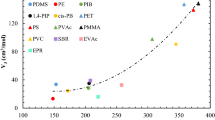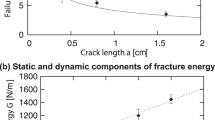Abstract
THE generation of new surfaces in a solid by rheological means affords the opportunity of studying the behaviour of these clean surfaces in respect to specific surface reactions. Thus a sensitive stress-strain record of the slow-plastic deformation of a solid is somewhat akin to the Heyrovsky dropping mercury polarograph in the respect of fresh surfaces being available for analytical (chemical, physical or electrochemical) studies. As a part of a fundamental ‘Instron’ precision tension apparatus study of first- and second-order transitions in some solid paraffins, we made a number of stress-strain tests of the mechanism of paraffin-detergent interactions in aqueous solutions. We wished to see whether the new surfaces produced by a slow (0.50 in./min.) plastic extension would interact to a measurable degree with two detergent solutions. Four representative specimens were tested in each of three environments: distilled water; a 0.4 per cent solution of technical grade sodium lauryl sulphate in distilled water; and a 0.4 per cent solution of technical grade sodium dodecyl benzene sulphonate in hard water. (The approximate composition of this Ponca City hard water was: calcium, 110; magnesium, 34; sodium, 180; potassium, 4; chloride, 284; sulphate, 167; bicarbonate, 329 p.p.m., the total solids being 888 p.p.m.) The hard water solution was used according to a suggestion of Dr. W. H. Harwood of our Research Department, who indicated (this was easily proved by simple beaker dipping tests) that a greater paraffin wetting action might be expected in waters containing the divalent ions of calcium and magnesium, these forming the corresponding detergent salts of decreased solubilities. The tensile specimens were prepared from a thin paraffin sheet formed by pouring liquid paraffin upon a clean, hot water surface.
This is a preview of subscription content, access via your institution
Access options
Subscribe to this journal
Receive 51 print issues and online access
$199.00 per year
only $3.90 per issue
Buy this article
- Purchase on Springer Link
- Instant access to full article PDF
Prices may be subject to local taxes which are calculated during checkout
Similar content being viewed by others
References
H. L. Falk, P. Kotin, A. Miller, Nature, 183, 1184 (1959).
Author information
Authors and Affiliations
Rights and permissions
About this article
Cite this article
RADD, F., CROWDER, L. Solid State Rheological Study of the Mechanism of Paraffin-Detergent Interactions in Aqueous Systems. Nature 184, 443–444 (1959). https://doi.org/10.1038/184443a0
Issue Date:
DOI: https://doi.org/10.1038/184443a0
Comments
By submitting a comment you agree to abide by our Terms and Community Guidelines. If you find something abusive or that does not comply with our terms or guidelines please flag it as inappropriate.



